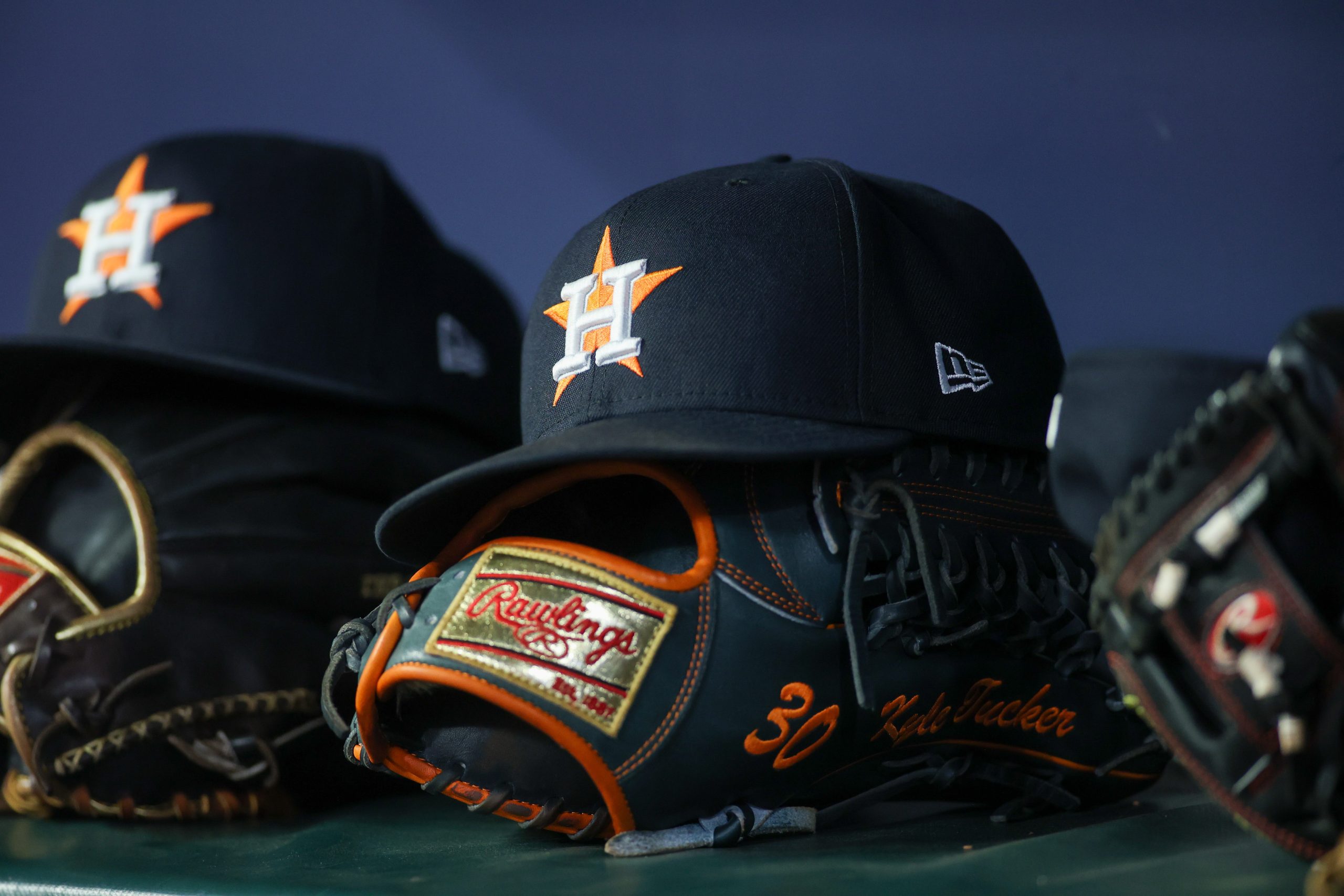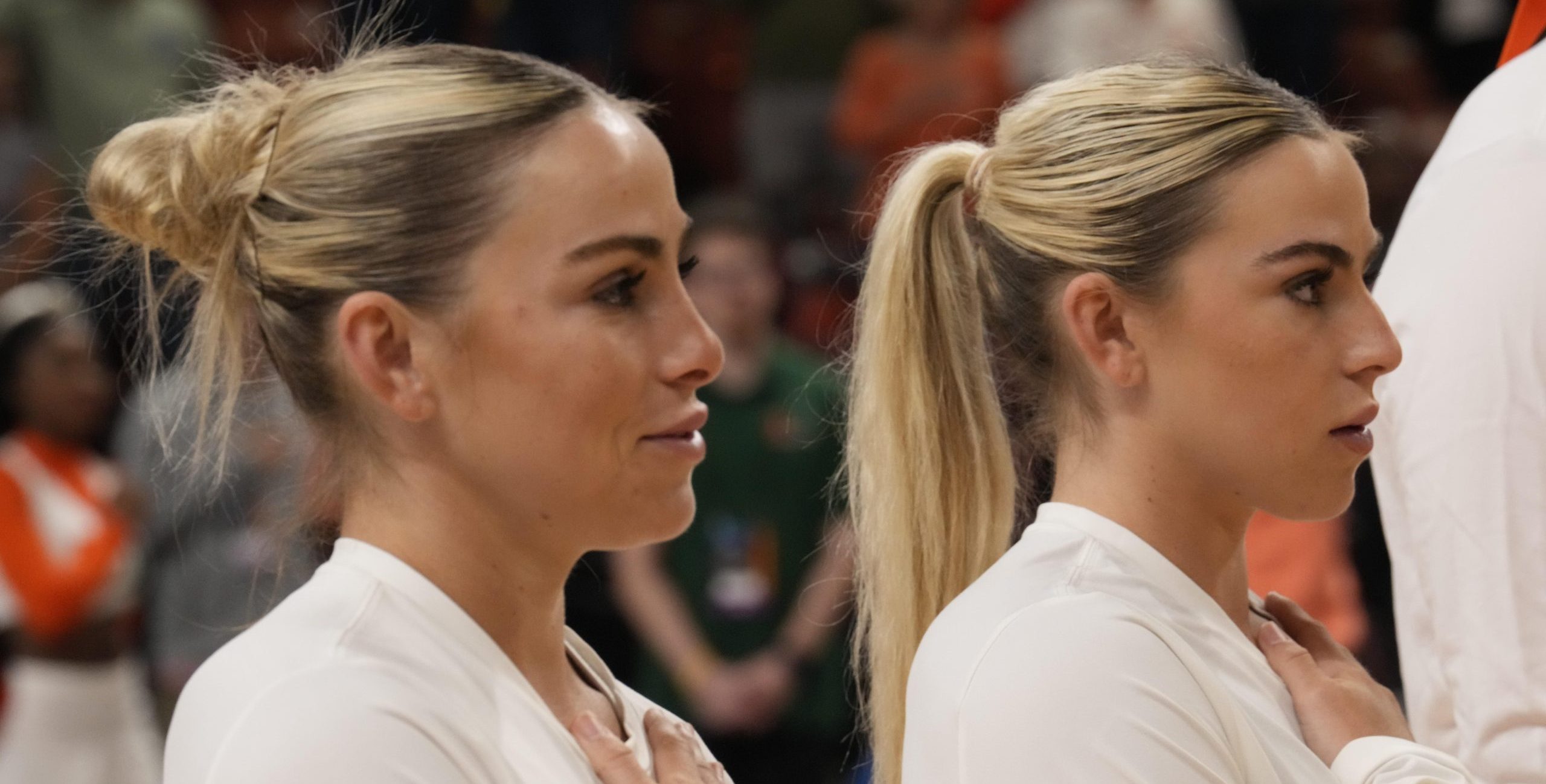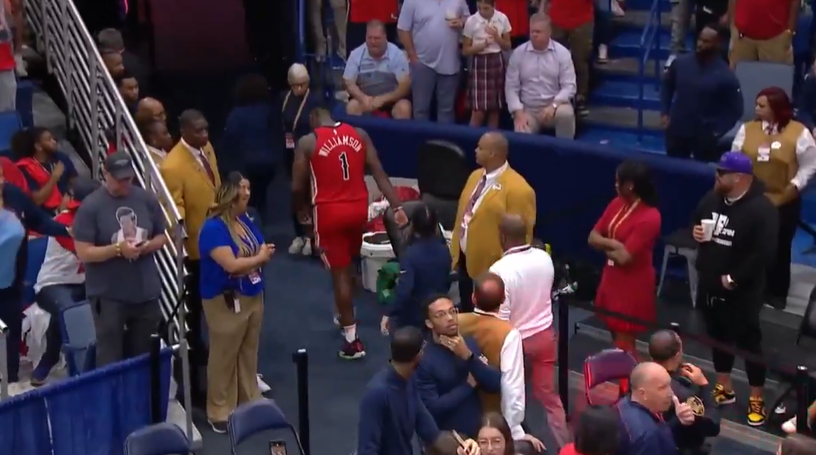The CFL concussion protocol is suddenly getting a whole lot of international attention, thanks to Johnny Manziel. There were questions raised about if Manziel might have suffered a concussion after he took a hard hit during the Alouettes’ game against the Ottawa Redblacks Saturday, but after a sideline evaluation, he went back in and finished the game (ending with 16 completions on 26 attempts for 168 yards in a 24-17 loss, which isn’t great, but is progress from his four-interception debut). And the next few days saw plenty of insistence that Manziel was fine, even after he missed practice for blood work Tuesday, with some of that insistence coming from Montreal head coach Mike Sherman.
That made things a little awkward Wednesday when the Alouettes announced Manziel was placed in the league’s concussion protocol. For example, it led to an interesting home page on the team’s official website (seen above) that juxtaposed a big “Johnny is fine and so is Sutton, according to Coach Sherman” headline in the middle with a small “Montreal Alouettes Statement” note on the right (which didn’t even mention Manziel, but is where their release on him entering that protocol is).
That release itself is notable, as it mentions that Manziel had some symptoms, but that they might be associated with medication he takes:
“On Tuesday morning, Johnny Manziel mentioned to our medical staff that he felt symptoms that could be associated with the prescribed medication he uses for a previously diagnosed medical condition. He then missed practice in order to have some blood work done. In view of the hit he received on Saturday and the potential mitigating side effects of his prescribed medication, the Alouettes medical staff has placed Manziel under the CFL concussion protocol for further observation and precautionary reasons. Manziel will be closely observed and assessed in the next few days.”
As of 11 p.m Eastern Wednesday night, that was the only mention of Manziel’s placement into the concussion protocol on the Alouettes’ site (and neither “Manziel” nor “concussion” is mentioned in the headline). They’ve since swapped the “Johnny is fine and so is Sutton, according to Coach Sherman” headline out for a “Fan-packed bus, action-packed game” post about the fan bus trip to Ottawa last week, but there’s no further mention of Manziel beyond that statement. But three of the site’s five left-hand “latest videos” are on Manziel (“Johnny Manziel on his first start in the CFL,” “Johnny Manziel’s best NCAA plays,” “Press conference with Johnny Manziel”), despite those all being weeks old. And the ad down the right hand side flashes between “Manziel, Manziel, Manziel” and “Order your custom Manziel jersey here!” Manziel’s also the only player featured in the top banner about the Alouettes’ next home game, which is at home in two weeks against the Toronto Argonauts.
However, the Alouettes’ next game is this Saturday on the road in Edmonton. And it doesn’t seem likely Manziel will play in it. Kayce Smith of Barstool Sports, who co-hosts their #ComebackSZN podcast with Manziel (so she’s presumably quite plugged in with him and his camp), wrote the following on Wednesday in response to the Alouettes’ statement:
Despite them saying he will be “observed and assessed”, I’m told definitively he will NOT be playing Saturday vs. Edmonton and will be continue to be evaluated for next week’s game vs Toronto.
On that podcast Thursday, Manziel discussed what’s going on with him, and unlike the Alouettes, specifically mentioned that he seems to have a concussion (transcription via 3 Down Nation):
“Dealing with just some headaches and what I’ve kinda been told looks like a delayed onset concussion, I guess. That’s what I’m dealing with some problems with my head a little bit. That’s the hardest part is not being there at practice, not being around the guys and having to be away for a couple days because I felt like we were getting into a rhythm, getting into a groove and the hardest part is stopping that right now. I started feeling a little worse as this week started to go on, hopefully, the next few days it will look a little bit better.”
“…The biggest thing that people were questioning was during the game I didn’t come out of the game, I don’t think there was any way I was going to come out of the game. But nevertheless, immediately after I was able to recall the plays we had on that drive, the score, I had a headache but not anything you’d expect from a hit like that,” Manziel said.
“The next couple days I felt decent, still was a little headache that was different than the norm, I couldn’t really tell if it was getting back in at three or four in the morning from Ottawa after the game on Saturday and not getting much sleep the next day or if I was having some problems. It just kind of went on and got a little bit worse. I’ll try to get back to my baseline and my norm a little bit. I’ll hopefully be back sooner rather than later.”
It should be noted that even this is a bit controversial, as Manziel’s making these comments on his podcast while the Alouettes are refusing to make him available to local media, as Herb Zurkowsky of The Montreal Gazette noted:
Here’s my thought for today: If @JManziel2 was healthy enough to record a podcast, why haven’t #Alouettes made him available this week to the media who cover the team on a regular basis?
— Herb Zurkowsky (@HerbZurkowsky1) August 16, 2018
But let’s move beyond that to Manziel’s comments about having a headache during the game and in the following days, whichraises a whole lot of questions about the concussion evaluation Manziel received Saturday and in the days afterwards.
For reference, here’s the hit in question, which saw Manziel take a direct blow to the head:
WHOA! Johnny Manziel takes a hit and the ball comes loose at the goal line — it's recovered by Kristian Matte for a @MTLAlouettes touchdown!#CFLGameDay pic.twitter.com/KEAfJEvg8H
— TSN (@TSN_Sports) August 12, 2018
It’s not, or at least it shouldn’t be, Manziel’s call if he could stay in the game after that. That’s a decision for team medical staffers. And as per TSN’s Matthew Scianitti (a regular sideline reporter on TSN’s CFL coverage), they followed standard protocol there:
1/2 I watch dozens of sideline concussions assessments. #AlsMTL did their jobs. Three medical professionals circled Manziel, checked his head & neck, asked him questions, which teammates heard&said Manziel answered “perfectly” Manziel was held out longer than 3 play minimum #CFL
— Matthew Scianitti (@TSNScianitti) August 15, 2018
2/2 What more could #AlsMTL do? If he’s not showing visible signs and is coherent (Questions: Where are you? What play did you just run?)& he’s held out longer than minimum time,what more can be done? Deeper question:Should players be held out because a hit looked bad on TV? #CFL
— Matthew Scianitti (@TSNScianitti) August 15, 2018
That is the deeper question, and from the perspective of players’ long-term health, the answer probably should be “yes.” Playing further after a concussion is particularly dangerous thanks to the chances of second-impact syndrome; there’s debate about just how prevalent that is, but it is fatal in many of the cases where it does occur. And some concussions show no symptoms at all at the time, with symptoms only arising later. Others present symptoms at the time, but it can be possible for players to hide them or overcome them while answering concussion-test questions (which is why a push towards objective concussion metrics such as bloodwork-based sensors is important).
In fact, a study published this January (based on a survey during the 2016 CFL preseason) saw 23.4 percent of CFL players mention that they felt they had suffered a concussion during the 2015 CFL season, but 82.1 percent of that group didn’t report it or seek treatment. That shows the massive scale of the problem with relying on information from players to diagnose concussions.
Now, the CFL has previously tried out the King-Devick Test with some success, which asks players to quickly read back numbers displayed on an iPad and has been described as more difficult to fool than standard questions like “Where are you?”; it’s unclear if the league’s still doing that and if that test was administered to Manziel or not, but it is also quite possible to pass even a test like that after a concussion. And Manziel’s comments on his podcast about “I had a headache” make it sound like he didn’t tell his full symptoms at the time to the staff evaluating him. So, yeah, if the goal is to get players who are concussed out of the game, it probably would make more sense to just pull players after a hit to the head, especially if video seems shows them seeming out of it (as it did with Manziel). That might avoid some of these situations where players pass tests, go back in, and are later removed. (And that’s happened before in the CFL, several times.)
Beyond that, the next question is about the concussed player’s return to play. As per the Alouettes’ release, Manziel was feeling some symptoms Tuesday (whether they were from a concussion or not). And he was placed in the protocol Wednesday. But Sherman said Wednesday (as per The Associated Press) that Manziel could potentially play Saturday if he was able to practice Thursday. While it doesn’t seem like that will be happening, that still raises a whole lot of questions about what the league’s concussion protocol actually is, as a turnaround of one day from “placed in protocol” to “cleared to practice” seems very problematic, as does a three-day turnaround from “placed in protocol” to “playing in a game.”
When it comes to the CFL’s concussion protocol, the general line in stories is that a player is placed in it, but there are usually few specifics on what exactly that means. As noted in 2012 around another case where a team tried to insist a player with a headache didn’t have a concussion (the Calgary Stampeders and Kevin Glenn in that instance), though, the CFL did do a very helpful thing in 2011, signing on to a joint national campaign with Football Canada, CIS (Canadian Interuniversity Sport, now U Sports), the CFL Players’ Association, the CFL Alumni Association, the CJFL and more and producing the following concussion recognition and return to play poster. It’s no longer available at the original link on the CFL’s site (possibly because it keeps being referenced as an example of them not actually following it), but Football Canada’s site still has it.
Here it is:
It’s that last part that’s really interesting, as 24 asymptomatic hours between each step would be at the very least five full days between a player diagnosed with a concussion and them returning to play. But the CFL doesn’t particularly follow that. And sure, it’s a 2011 document and they may have a better one at this point, but if they are following a specific timeline, it’s one that’s been shortened from this, which doesn’t seem like a great thing for player health. It’s also notable that the NFL does publish its return-to-play protocol, “adapted from the 4th International Concussion in Sports Conference,” which covers all the same steps (only combining points 5 and 6), but has some interesting specifications:
“There is no set time-frame for return to participation or for the progression through the steps of the graduated exercise program set forth below. Recovery time will vary from player to player. The decision to return a player (hereinafter referred to as the “player-patient”), to participation remains within the professional judgment of the Head Team Physician or Team Physician designated for concussion evaluation and treatment, performed in accordance with these Protocols. All return to full participation decisions are to be confirmed by the Independent Neurological Consultant (INC).”
That appears to be more what the CFL actually follows (absent the evaluation by an independent neurologist, something the players’ association fought for in the 2014 collective bargaining agreement negotiations but did not get), essentially “You’re good to go after the team physician clears you, no matter how quickly that comes after you’re showing symptoms.” And it’s understandable why professional football teams want a system like that; a player not playing has consequences for them, and that’s perhaps especially notable when it’s the starting quarterback. It sounds like Montreal will be turning to Antonio Pipkin, who has nine career CFL passes (and two completions) from relief work in the Alouettes’ regular-season finale last November. But they’d definitely rather play Manziel if he was healthy.
But while it’s in the short-term interests of teams and the league to get stars back out there, and while that’s what many players even want in the moment (why deceiving concussion tests is an issue), that’s probably not the best for anyone in the long term. It should be noted that countless CFL alumni have had massive long-term health problems from concussions, leading to multiple lawsuits, and that CTE has been found in many former CFL players. The litigation against the CFL has hit some setbacks, with the Supreme Court of Canada declining to hear Arland Bruce III’s case (upholding a lower-court ruling that his claims should be settled through arbitration), and it may never wind up with the same sort of settlement seen in the NFL (a big part of that case was evidence the NFL knew of the dangers of concussions and didn’t tell players; that hasn’t been proven in the CFL), but concussions are still a huge issue for the league. And they’ll continue to be one going forward.
Publicly, the league and its teams often talk about how seriously they’re taking concussions, and that’s good. And they’re making some promising steps, such as ending full-contact practices during the season (a move announced last year). But cases like the Manziel one illustrate that not all apparent concussions are caught by the existing tests, and that that the return-to-play protocol really isn’t all that long or all that strict, certainly not as long as the one the CFL signed off on in 2011. And they provide an excellent opportunity for reporters to really dig into how the league and its teams handle concussions, and if improvements should be made. Hopefully that will happen, and we’ll get more coverage than just “placed in the concussion protocol” or “a statement from the Alouettes.”






